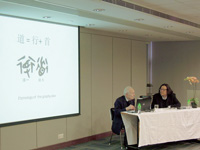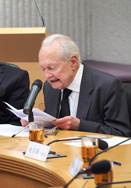Professor Léon Vandermeersch was invited to CUHK as a visiting professor under the Jao Tsung-I Visiting Professor Scheme. His cycle of lectures included four public talks, each one dealing with a different topic. These lectures share two essential concepts: Chinese and Western cultures are characterised by different origins, developments, problems and inner workings; and the differences between these two cultures can be traced back to their earliest developments. Below, we provide a brief synopsis of each lecture. Lecture I: Chinese Manticology versus Western Culture Theology  The first lecture, "Chinese Manticology versus Western Culture Theology", focused on the fundamental role of language in the early development of Chinese culture. Professor Vandermeersch started from the analysis of the two dimensions of language: communication (words) and knowledge (concepts). He defined the "knowledge" dimension as the original feature of the early Chinese writing system, generated in the context of divination as a "really ideographic system" ("ideography" etymologically meaning idea, concept, and graphein, to write) independently from oral language. Therefore, Professor Vandermeersch argued that the maturation of the Chinese thought process as dominated by correlation, in opposition to the Western reliance on causality, depended on the separation of written and oral language and on the ideographic nature of Chinese characters. This is evident in the development of "Chinese scapulomancy" through five stages, characterised by a refinement of the mantic techniques that favour relations of correlation: for example, the choice of turtle shells for divinatory purposes had a symbolic function (the correlation of the shell's shape with the cosmos) and not a practical use; the later substitution of numbers to crack shapes was also based on similarities between the shape of the numbers themselves and the cracks on the mantic implements, instead of the former's mathematical value. The first lecture, "Chinese Manticology versus Western Culture Theology", focused on the fundamental role of language in the early development of Chinese culture. Professor Vandermeersch started from the analysis of the two dimensions of language: communication (words) and knowledge (concepts). He defined the "knowledge" dimension as the original feature of the early Chinese writing system, generated in the context of divination as a "really ideographic system" ("ideography" etymologically meaning idea, concept, and graphein, to write) independently from oral language. Therefore, Professor Vandermeersch argued that the maturation of the Chinese thought process as dominated by correlation, in opposition to the Western reliance on causality, depended on the separation of written and oral language and on the ideographic nature of Chinese characters. This is evident in the development of "Chinese scapulomancy" through five stages, characterised by a refinement of the mantic techniques that favour relations of correlation: for example, the choice of turtle shells for divinatory purposes had a symbolic function (the correlation of the shell's shape with the cosmos) and not a practical use; the later substitution of numbers to crack shapes was also based on similarities between the shape of the numbers themselves and the cracks on the mantic implements, instead of the former's mathematical value.
Conversely, Western writing had its raison d'être in being a representation of the oral language, and was gradually rationalised from a logographic into the alphabetical system still in use. The use of verbal communication as a creative force in Biblical traditions is just one example of the close relationship between spoken word and aetiology in early Western cultures. In this way, and comparing the origins of Chinese culture with those of Western (i.e., early European) culture, Professor Vandermeesch concluded that, while the latter was dominated by the concept of causality (expressed in the development of aetiological thought), in Chinese culture events were linked to omens (leading to a morphologic process of enquiry). Lecture II: Characteristics of Chinese Scientific Thought Having demonstrated that Chinese thought relies on a correlative methodology generated from manticology, Professor Vandermeesch determined how this perspective on reality influenced Chinese epistemology and scientific thought. According to his paradigm, Chinese thinkers' attempts to understand reality passed through an understanding of the similarities between entities, in particular the latter's "yinyang wuxing structure": in this sense, Chinese correlative thinking was anchored to manticology. Professor Vandermeersch stated that "correlativity does not exclude causality": this means that while Chinese thinkers did rely on the principle of causality, this was only to explain simple phenomena, whereas they adopted correlativity to solve complex problems (among which we find politics and medicine) that could not be otherwise analysed with a causal technique, which was considered too crude and simplistic. The case of medicine, "the queen of Chinese sciences", serves to clarify this traditional approach. Chinese doctors focused on developing physiology much more than anatomy, because they were interested in the function and interaction of the organs, more than their position. Again, the emphasis was on the correspondence "not only between the organs of the body, but between body and mind, and between the body and the mind and the cosmos", making Chinese medicine fundamentally "cosmo-psycho-somatic". Chinese science was probably even more advanced than European science until the Enlightenment, when the latter managed to achieve a technical predominance. Professor Vandermeersch noticed that this rapid development of Western science was due to the purging of mistaken principles inherited from theology: his wish is that Chinese correlative thinking, which can surely bring richness to contemporary science (especially in such fields as probability, statistics, quantum physics and computer science), will also experience an "Enlightenment" that will purge from it misleading principles related to its manticological origins, such as yinyang, wuxing and the Yijing hexagrams. Lecture III: Memories of My Relations with My Laoshi Jao Tsung-I The third lecture, "Memories of My Relations with My Laoshi Jao Tsung-I", was a fascinating account of Professor Vandermeersch's fondest memories of his relationship with Jao Tsung-I. Dr Charles Yeung, chairman of Glorious Sun Holdings Limited and GS Charity Foundation Limited, inaugurated this event by donating HK$10 million to the Jao Tsung-I Visiting Professorship Scheme. The lecture was attended by many other notable guests, including Professor Jao Tsung-I himself, Professor Joseph Sung (Vice-Chancellor of CUHK), Professor Leung Yuen-Sang (Director of the Institute of Chinese Studies of CUHK), Ms Yiu Ching-Fun (Director of the Jao Tsung-I Foundation), and representatives of the patrons of the Jao Tsung-I Visiting Professorship Scheme. Professor Vandermeersch shared with the audience stories about his experience as Jao Tsung-I's student and friend, and his memories of many famous scholars of Chinese Studies. The full text of his lecture can be found here.  
Lecture IV: Characteristics of Chinese Literature and Arts The fourth lecture was a comparative study of Western and Chinese art and literature. These two areas of human knowledge have developed differently in the two civilisations, and Professor Vandermeersch argued that this difference can be attributed to the diverse origin and development of the writing systems used in Europe and China since ancient times. In both Western and Chinese cultures, language was a means to define and understand the universe, but the development of this concept has been different in the two civilisations, being specifically related to two distinct speculative processes: theology and manticology. In the West, the oral word was traditionally attributed with creative power, marking the paramount importance of oral language. In China, instead, it was the wen, the written mark, that was characterised by transcendent power and sacredness, and was peculiarly endowed with a revealing function: this was inherited from the revealing function of scapulomantic cracks and, through their later development, Chinese ideography. In this way, Professor Vandermeersch has explained why the concept of Creation did not make sense within the Chinese speculative framework. Therefore, language in the West was assimilated to the creative power of Nature (or God), which meant that the author himself, by the use of language, was driven to imitate the workings of Nature: in so doing, though, he separated himself from Nature by creating something other. In Chinese literature, instead, the author attempted to describe Nature from within, and to enter into contact with it, just as the shaman employed techniques to establish a connection with Nature during divinatory practices. As a consequence, according to Professor Vandermeersch, it is possible to understand why in China there is a genetic relationship between literature and shamanism: precisely because there is a radical filiation between writing and divination. The difference between Western literature and Chinese literature is evident also in the different status that "originality" plays in them: a necessary characteristic in the first case, but not in the latter. |















